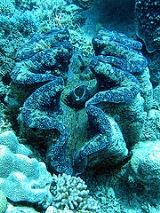
Giant clam
Overview
The giant clam, Tridacna gigas (known as pā’ua in Cook Islands Māori
), is the largest living bivalve mollusc. T. gigas is one of the most endangered clam species. It was mentioned as early as 1825 in scientific reports. One of a number of large clam
species native to the shallow coral
reefs of the South Pacific
and Indian ocean
s, they can weigh more than 200 kilograms (440.9 lb) measure as much as 120 cm (47.2 in) across, and have an average lifespan in the wild of 100 years or more.
Cook Islands Maori
The Cook Islands Māori language, also called Māori Kūki 'Āirani or Rarotongan, is the official language of the Cook Islands. Most Cook Islanders also call it Te reo Ipukarea, literally "the language of the Ancestral Homeland"....
), is the largest living bivalve mollusc. T. gigas is one of the most endangered clam species. It was mentioned as early as 1825 in scientific reports. One of a number of large clam
Clam
The word "clam" can be applied to freshwater mussels, and other freshwater bivalves, as well as marine bivalves.In the United States, "clam" can be used in several different ways: one, as a general term covering all bivalve molluscs...
species native to the shallow coral
Coral
Corals are marine animals in class Anthozoa of phylum Cnidaria typically living in compact colonies of many identical individual "polyps". The group includes the important reef builders that inhabit tropical oceans and secrete calcium carbonate to form a hard skeleton.A coral "head" is a colony of...
reefs of the South Pacific
Pacific Ocean
The Pacific Ocean is the largest of the Earth's oceanic divisions. It extends from the Arctic in the north to the Southern Ocean in the south, bounded by Asia and Australia in the west, and the Americas in the east.At 165.2 million square kilometres in area, this largest division of the World...
and Indian ocean
Indian Ocean
The Indian Ocean is the third largest of the world's oceanic divisions, covering approximately 20% of the water on the Earth's surface. It is bounded on the north by the Indian Subcontinent and Arabian Peninsula ; on the west by eastern Africa; on the east by Indochina, the Sunda Islands, and...
s, they can weigh more than 200 kilograms (440.9 lb) measure as much as 120 cm (47.2 in) across, and have an average lifespan in the wild of 100 years or more.

